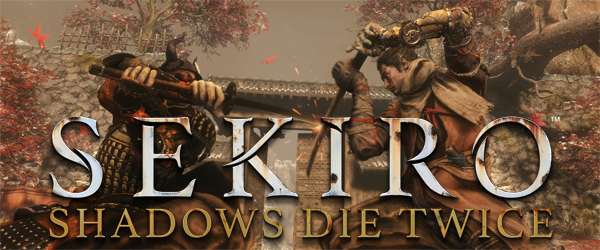
I never got into Tenchu because the
demos were too hard for younger me.
Oh, boy, was this a tough game to play and review! Frequent readers should probably know that I'm a huge Souls-Borne fan -- to the point of writing strategies and lore analyses. Sekiro is a bit different, however. It's much further divorced from Dark Souls than even Bloodborne was. Despite the lack of "Souls-Borne-ness" of Sekiro, I find it very difficult to put this review in any context other than of a new Souls-Borne release.
Sekiro is, ostensibly, a stealth game. There's more of Tenchu and Metal Gear in Sekiro than of Dark Souls. That's not necessarily a bad thing. I like stealth games just fine. The Metal Gear Solid games rank among one of my favorite game series ever.
I'm not terribly familiar with Tenchu, though. I think I played a demo of a PSX Tenchu game on one of my Official PlayStation Magazine demo discs (back in the day when publishers let players play pre-release demos, for free, instead of expecting us to pay for games long before they're even released, or holding the "open beta" hostage to a pre-order). I never bought the full Tenchu game because the demo was far too hard for my little 13 or 15-year-old gamer skills to handle. This was, of course, long before I started playing more demanding games.
Sekiro is in an awkward juxtaposition between Tenchu-inspired stealth, and Dark Souls-inspired boss fights.
However, there seems to be a certain degree of juxtaposition between Sekiro's desire to be a Tenchu-like stealth game, and its desire to feature demanding boss fights in-line with what is given in Souls-Borne games. In essence, we have two games here: a stealth game about staying out of sight of enemies and picking them off one-by-one; and a melee boss gauntlet in which the stealth isn't applicable at all. The first of those is good enough. The second one is where my problems begin...
My first playthrough of Demon's Souls was spent
cowering behind a shield.
All parry, all the time
You see, this really comes down to play-style. I was never a big parry-er in my Dark Souls-playing days. I parried a lot more in Bloodborne, but a big reason for that was that the guns allowed me to do so from a relatively safe distance. Heck, my first playthrough of Demon's Souls was done as the Royalty class, starting with the mana-regen ring, stabbing out with a winged spear from behind a shield, and using Soul Spear to dispatch any enemies I wasn't comfortable fighting up close. I hardly realized the parry mechanic existed!
Of course, I've grown and matured since 2008, and parrying has become a common element of my play-style. But I've still never been particularly good at it. This is causing me a lot of trouble in Sekiro because Sekiro's combat is all parrying, all the time! The new posture mechanic (which essentially replaces stamina) also means that a single parry isn't good enough to riposte and kill your enemy. You have to parry each strike in flurries of blows. For those coming from Dark Souls, imagine having to fight a hollow undead, and needing to parry every one of its wild slashes before you can riposte, instead of just the first one. That is what Sekiro expects and requires you to do.
Sekiro requires that you parry most attacks.
If you were a master-level parry-er in Dark Souls III, then you'll probably segue right into Sekiro with no problem and wonder what all the fuss is about. But for the rest of us plebs, that isn't going to be so easy.
This game plays much faster, enemies are much more aggressive, and health is in much smaller supply. Almost everything will kill you with two hits, and many grab attacks will drop you from full health to zero. This game leaves you with virtually no margin for error! Yet the mini-bosses and bosses have ridiculously high HP and posture.
... [More]
ecd29173-9c96-446a-944a-ddc20d5687ab|1|5.0
Tags:Sekiro, Sekiro: Shadows Die Twice, From Software, Activision, Hidetaka Miyazaki, Tenchu, Dark Souls, Demon's Souls, Bloodborne, stealth, boss, Japan, shinobi, samurai, mythology, lore, parry, deflect, deathblow, grinding

Before we get very far into this, I want to acknowledge a point that you might be thinking right now: "But MegaBearsFan, Yorshka tells us who her parents are!" Or at least, she tells us that her father is Gwyn and her sister is Gwynevere and her "brother" is Gwyndolin. Seems pretty cut-and-dry right? OK, blog post over. If I keep writing on topics like this, I'm going to become very prolific!
... Well, maybe it's not quite that simple. This all seems rather fishy, and I'm not so sure if I'm willing to take Yorshka's words at face value. We still have the Ringed City DLC coming out for Dark Souls III at the end of this month, so it's entirely possible that DLC will settle the questions raised in this post. But until then, please humor me as I take a dive down a bit of a rabbit hole.
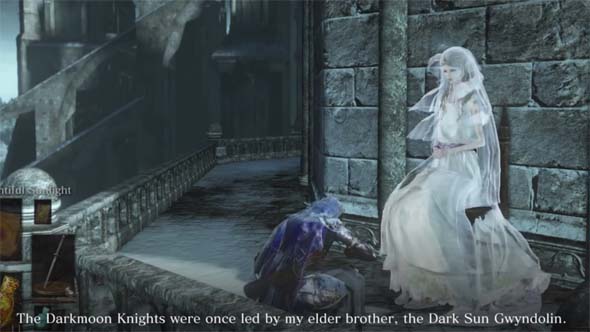
Yorshka directly states that Dark Sun Gwyndolin is her brother.
Before we go any further, let's take a look at what Yorshka actually says - her full dialogue can be conveniently read on fextralife (among other Souls wikis). When you meet Yorshka and perform the Darkmoon loyalty, she mentions:
"If thou shalt swear by the Covenant, to become a shadow of Father Gwyn and Sister Gwynevere,
A blade that shall hunt the foes of our lords;
Then I place thee under the aegis, and the power, of the Darkmoon."
If you level up in the covenant, she'll go on to talk about her relation to Dark Sun Gwyndolin:
"The Darkmoon Knights were once led by my elder brother, the Dark Sun Gwyndolin.
But he was stricken by illness, and leadership of the knights fell to me.
Then Sulyvahn wrongfully proclaimed himself Pontiff, and took me prisoner.
Oh where could my dear brother be?"
If you take this all at face value, then it seems pretty cut-and-dry, but take another look at the actual subtitle text. When she talks about Gwyn and Gwynevere, she uses the words "Father" and "Sister" (respectively), implying that Yorshka may be the daughter of Gwyn and blood sister to both Gwynevere and Gwyndolin. However, notice that, unlike when speaking of her brother, the words "Father" and "Sister" are capitalized, as if they are proper nouns or - more likely - titles... [More]
79ecc47f-30da-4747-ac2f-b4ec639b22b0|2|5.0
Tags:Dark Souls, Dark Souls III, From Software, lore, Yorshka, Blades of the Darkmoon, Darkmoon, Gwyndolin, Gwyn, Gwynevere, Anor Londo, Irithyll, Faraam, Nameless King, God of War, dragon, crossbreed, Priscilla, Velka, Caitha, Fina, Seath the Scaleless, Dusk, Oolacile, Oceiros, The Painted World of Ariamis, religion

Perhaps I just have a bias against parallel dimensions (as evidenced from my interpretation of Silent Hill's otherworld), but I want to take some time to clear up what might be a mis-conception in the conventional wisdom interpretation behind Dark Souls' multiplayer summoning mechanics. Dark Souls co-op is not necessarily based on parallel dimensions, as many players seem to assume. It might, in fact, be intended to be an abstraction of some kind of time travel. I've noticed that many players online already seem to refer to the multiplayer mechanic of these games in terms of time travel, but I've yet to see any wikis, lore videos, or blogs that seem to explain multiplayer as a time travel mechanic.
I want to preface this analysis by stating that I'm not asserting that the following explanation is the absolute, 100% correct interpretation of the mechanic. Individual players may disagree based on their own reading of the game, and I'm personally somewhat conflicted on the topic myself. I merely want to propose this as a possible alternative to the defacto "parallel worlds" interpretation. I'm going to point out in-game evidence that supports the idea that Dark Souls' multiplayer is based on time travel, but there is also in-game evidence and mechanical evidence that flat-out contradicts that interpretation. I will address those contradictions as well. So that being said, please keep an open mind, and enjoy the read!
The summoning mechanic
There are two games in the series that are not part of the Dark Souls franchise, and which have different in-game explanations and rules for the same multiplayer features (more or less). Those games are, of course, Demon's Souls and Bloodborne. Both have asynchronous multiplayer and summoning mechanics that work similarly to Dark Souls.
Demon's Souls summoning operates under the idea of summoning the spirit of a fellow adventurer who's soul is trapped in the Nexus. This is why you must be in soul form in order to be summoned. Bloodborne's beckoning operates [similarly] under the principle of manifesting hunters out of dreams (which seems to operate under a similar cyclical paradigm to Dark Souls, but I'm not 100% sure). In Dark Souls, you aren't necessarily summoning ghosts (as you do in Demon's Souls), since the undead in Dark Souls are more akin to zombies than ghosts. Also, characters in Dark Souls can leave summon signs whether they are hollowed (dead) or in human form (revived), which is a significant alteration from Demon's Souls. A lore reason for summoning is provided in Dark Souls:
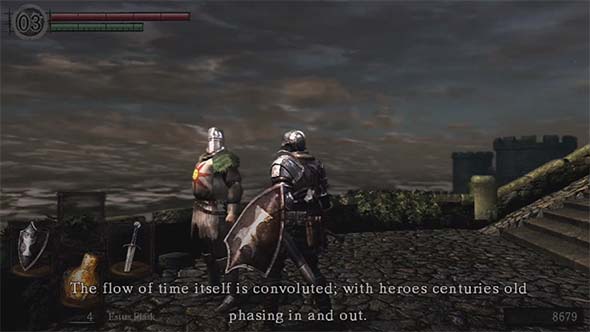
Solaire explains to us how summoning works:
"We are amidst strange beings, in a strange land.
The flow of time itself is convoluted; with heroes centuries old phasing in and out.
The very fabric wavers, and relations shift and obscure.
There's no telling how much longer your world and mine will remain in contact.
But, use this, to summon one another as spirits, cross the gaps between worlds, and engage in jolly co-operation!"
Both Solaire's dialogue, and the White Sign Soapstone (along with other online play items) make references to other "worlds", which leads to many jumping to the conclusion that each player's game is a sort of parallel universe within the Dark Souls lore. However, this may not necessarily be correct. Both Solaire's dialogue and the soapstone also provide explanations for these worlds: "time is convoluted | distorted". This seems to be the explanation for what is meant by "worlds", and it seems that Solaire and the in-game descriptions may be using "time" and "world" interchangeably (could it be a translation / localization issue?). The phrasing in the white soapstone's description joins "the flow of time is distorted", and "the White Soapstone allows undead to assist one another", into a single, compound sentence, which definitely implies that the two phrases (and ideas) are linked.
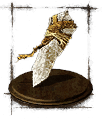
"Online play item. Leave summon sign.
Be summoned to another world as a phantom through your sign, and defeat the area boss to acquire humanity.
In Lordran, the flow of time is distorted, and the White Sign Soapstone allows Undead to assist one another"
The dialogue of Saulden (the Crestfallen Warrior of Dark Souls II) is even more explicit... [More]
b4b5ccdc-fe67-4add-901b-a41077204778|4|5.0
Tags:Dark Souls, Dark Souls II, Dark Souls III, lore, summon, phantom, multiplayer, From Software, time travel, paradox, grandfather paradox, predestination paradox, parallel dimension, soapstone, Solaire, Crestfallen
Warrior, Crestfallen Saulden, Lautrec, Ringfinger Leonard, Anri of Astora, Sirris of the Sunless Realms, Black Iron Tarkus, Iron Golem, Anor Londo, invasion, Demon's Souls, Bloodborne
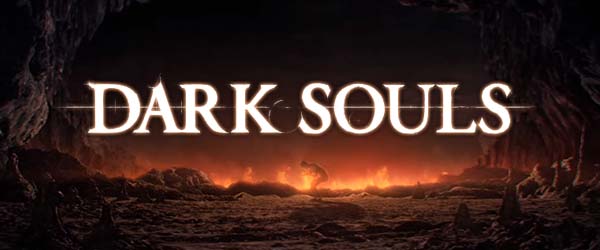
I'm going to do something that I don't normally do, which is to muse a little bit on the theories of other fans. Normally, when I write these lore posts, I write about what I believe - my own personal interpretation. In this case, however, I stumbled upon a video and a blog written by two different users that posit two entirely different (and probably contradictory) fan theories regarding the Souls games. Both theories piqued my interest and lead me down a rabbit hole of my own thought and speculation. So I'm going to summarize the theories that these two have pitched, and also throw in my own thoughts.
But first, let's review the conventional Dark Souls wisdom of the cycles of Fire and Dark. According to conventional wisdom, the dragons and archtrees of the Age of Ancients existed at the genesis of the world. The fire then appeared and ushered in the Age of Fire, but the fire faded, and the Age of Dark began. Lord Gwyn sacrificed himself to rekindle the flame and renew the Age of Fire, but it eventually faded again, leading to an Age of Dark. And the world continued in this endless cycle of the fire
fading and then being rekindled.
An overarching cycle of world-creation?
First, I'll start with a video by The Ashen Hollow, which is about the Cycle of Ages, and which speculates that the Soul of the Lords and Age of Dark ending establishes that the Age of Dark eventually gives way to yet another Age of Ancients. This creates a cycle of cycles, in which not only does the world of Dark Souls repeat Ages of Fire and Ages of Dark, but that once that cycle has run its course, it repeats yet another cycle of world-creation. Dark Souls III, therefore, takes place at the end of an Age of Fire, but it also takes place at the tail end of a cycle of world-creation and destruction. So Dark Souls III is a sequel to the first Dark Souls, and also the first Dark Souls is - in a sense - a sequel to Dark Souls III.
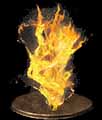
"Soul of the Lords.
One of the twisted souls, steeped in strength.
Use to acquire numerous souls, or transpose to extract it's true strength.
Since Lord Gwyn, the first Lord of Cinder, many exalted lords have linked the First Flame, and it is their very souls that have manifested themselves as defender of the flame."
When the fire inevitably fades, there will be an Age of Dark. This we know. The entire game series, so far, has been about perpetuating this Age of Fire for as long as possible in order to avoid the Age of Dark. Though the first and third game gives us the explicit option to initiate an Age of Dark, it's unclear if that ever actually happens in the canon of the series. And even if it does, the ending of Dark Souls II establishes that either course of action will just result in that chosen age cycling back to the other. We've never actually seen a proper Age of Dark, so we know little of what it would be like. Perhaps the Age of Dark is not permanent. According to the Fire Keeper (if given the Eyes of a Fire Keeper), the Age of Dark is not completely without fire, for there will be little embers dancing in the distance, left to us by past lords. [More]
f4e772f4-cf45-45f5-a271-3c8dd01253f5|3|5.0
Tags:Dark Souls, lore, Age of Ancients, Age of Lords, Age of Fire, Age of Dark, Age of the Deep Sea, cycle, prophecy, Dark Soul, humanity, Furtive Pygmy, Gwyn, first flame, Kiln of the First Flame, archtree, Archdragon Peak, dragon, puss of man, light, dark, Soul of Lords, Ebrietas, Seath the Scaleless, Patches, Moonlight Greatsword, Marvelous Chester, Oceiros, Demon's Souls, Bloodborne, Old One, fog, soul, blood, The Ashen Hollow, James Wynne, H.P. Lovecraft, Armored Core, King's Field

A couple years ago, I posted about a burning question in Dark Souls' lore: who is the "forgotten" god of war (first-born sun of Gwyn) who was expunged from the annals of Anor Londo? At the time, the leading theory was that Solaire was intended to be the firstborn god of war, and I tentatively went along with that interpretation. There were a few holes in the theory, a lot of it was circumstantial, and there were even a couple of alternative possibilities. I also wholly admitted that it was very likely that the god of war character simply wasn't present in the original game, except through the lore references in the environment and item descriptions. Dark Souls II did little to answer this question, other than to provide a possible name for the god of war: Faraam. Well, it turns out that Dark Souls III finally answers this question, and all of us who thought it might be Solaire were totally wrong - and may even look foolish in retrospect.
As is so often the case with Souls games, you'll have to work hard to find all the good lore. In this case, you'll need to find and conquer the optional Archdragon Peak area of the game, which, itself, requires that you find the Untended Graves optional area as well.
These statues of the Nameless King resemble the statue and pose of Gwyn in the first game.
Once you make it to Archdragon Peak, you'll be treated with a large, sunny area populated with serpent men that should look familiar to veteran Dark Souls players. I'm still unclear regarding the lore behind these enemies. The original man serpents from Dark Souls were hybrid creations of Seath's experiments. Perhaps the man serpents in Archdragon Peak are the progeny of the original serpent men from Sen's Fortress. More importantly, however, is that Archdragon Peak is also home to the Ancient Wyvern and the Nameless King.
During your encounter with the Ancient Wyvern, you'll get your first clue as to the lore that will be uncovered in this area. You'll find regal statues of a being holding a massive swordspear weapon. The style and pose of this statue may remind you of the statues of Gwyn that you saw in Anor Londo in both Dark Souls and Dark Souls III. The way that the character is standing, and the way that he's holding his weapon looks like he could fit in perfectly standing next to Gwyn in the Anor Londo cathedral...
[More]
7e4d29a3-895e-4a8b-8da9-36053957ccf0|3|4.7
Tags:Dark Souls, Dark Souls II, Dark Souls III, lore, From Software, Hidetaka Miyazaki, God of War, Gwyn, Faraam, Nameless King, Archdragon Peak, Untended Graves, dragon, Dragonslayer Ornstein, Solaire, son, sun, Warrior of Sunlight, annals, Anor Londo, Velka, DLC, Ashes of Ariandel, Ariamis
|

| 12 | | | | | | | 60 | | 11 | | | | | | | 55 | | 10 | | | | | | | 50 | | 09 | | | | | | | 45 | | 08 | | | | | | | 40 | | 07 | | | | | | | 35 | | 06 | | | | | | | 30 | | 05 | | | | | | | 25 | | 04 | | | | | | | 20 | | 03 | | | | | | | 15 | | 02 | | | | | | | 10 | | 01 | | | | | | | 05 |
|